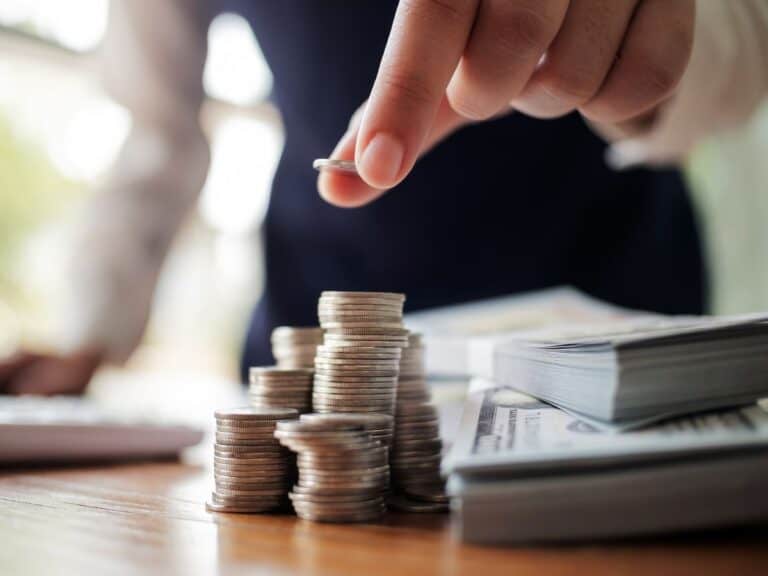Knowing Good Dividend Yield: (A Guide How To Spot One in 2023)
Whether you’re new at investing or have been in the game for a while without knowing what to look for, being able to tell what a reasonable dividend yield is essential to ensure you have financial growth. Though many believe a higher dividend return is always better, other factors should get considered.
If you want to expand your knowledge, below, you can learn what a good dividend yield is.
Though it may differ based on your personal income needs, a reasonable dividend yield can generally be between a 2% and 5% yearly return. Several methods exist to determine whether a stock offers a good dividend yield, including using the payout ratio or comparing it to similar stocks.
Though you may get tempted to buy a stock based on its dividend yield, if it is higher than many other companies, it is essential to understand how the dividend yield can tell you whether a stock is a safe investment.
If a stock offers a lower dividend than what is reasonable or offers more than the expected yield, the investment may present a more significant risk or not be worth it.
Table of Contents
What Does Good Dividend Yield Mean?
If you want to find a stock with a good dividend yield, you need to consider a few key points, including whether the yield is enough to suit your needs and whether the yield shows the possibility of future problems for the company.
We first need to discuss whether the dividend yield is enough to suit your needs. Though not everyone is looking for high dividend returns, a higher dividend yield is probably the best to consider if you want to make a passive income with smart investments or add to your income.
Simply looking at the yearly dividend yield will allow you to determine whether a company can help you add to your income or if the yield is too low to be helpful in your situation.
For example, suppose you choose between companies of similar size, value, and growth. In that case, you may want to invest in the company giving a 4% dividend yield over a company offering only 2.5% if you want passive income.
However, it is also essential to consider that when stocks offer a larger dividend yield than what you expect or more than 5%, this may not be the best investment if you are looking for a more long-term dividend return.
If you’re looking to find the meaning of good dividend yield, it is a dividend yield that is high enough to be a good investment while not increasing the risk.
How Is Dividend Yield Calculated?
If you want to see whether a dividend yield on a stock is considered good, you will likely want to know how you need to calculate the yield percentage. Though you may think the math may be tricky, the process is relatively straightforward.
A stock’s dividend yield is the total yearly amount of dividends divided by the current price of a share for that company. For example, if the price of a claim is currently 100 USD, and you receive a quarterly dividend of 50 cents or 2 USD per year, the yield is $2 divided by $100.
In this example, the dividend yield for this stock, which costs $100, would be 0.02. If this seems confusing, you can multiply the initial result by 100 to receive the dividend yield percentage of 2% in our example.
While considering this, it is critical to note that companies often pay out dividends over a year, commonly quarterly. Because companies split up the payments, the simplest way to determine the dividend yield is by adding the four quarterly payments together before dividing it by the stock cost at that point.
You should also note that dividend yields may differ, and because the dividends commonly get paid quarterly, so will the dividends themselves. Because of this, you may end up with four different amounts from the same shares that you must add together before dividing and finding the dividend yield percentage.
We must also note that this calculation is done on a per-share basis, meaning that, to make things simpler, you should add up the dividends of a singular stock share instead of adding up all of your combined shares’ dividends.
What Do You Need To Know About A Company’s Dividend Yield?
Knowing a reasonable return on your investments and understanding what a dividend yield is and how high it should be is an excellent way to decide whether it is worth buying shares in a company. However, knowing these key aspects can also help you stay informed about the companies you are invested in, even after you buy shares.
Once you have bought shares in a company, it is always best to keep an eye on your investments and the return you can make from them yearly. The best way to ensure we can keep track of what is going on with our stocks, by looking explicitly at their dividend yield, here are a few things you may need to know.
What Does It Mean If Dividend Yield Is Too Low?
There are two main reasons a company’s dividend yield may be low, one of which may make you reconsider investing in it. The two main reasons are:
- A decline in the company’s market value or a lowering stock price.
- Ensure that the business can grow by reinvesting most of the returns they get.
It is always best to analyze the dividends you receive and the current dividend yield compared to previous dividend yields. By looking at the current dividend yield compared to the last dividend yields, you may more clearly see how a company is doing and be able to tell whether a company will be a safe long-term investment.
The first reason a company may be decreasing its dividend yields is that its value on the market is reducing, and so is the stock price. It may be that a company is not making as many sales as it used to, or its worth is slowly becoming less, which means the funds that would usually pay out dividends may be used for something else to keep the company afloat.
If this is the case, it is usually not a safe long-term investment, and you may consider buying stocks in another company instead.
However, the other reason for lower-than-average dividend yields could be that a company is still relatively new or small and is pushing as much money into development and growth as possible.
In this case, investing in a company that is actively trying to expand and grow may be a good investment since it is likely that the dividend yield may increase as the company becomes older and more established.
It is not uncommon for smaller companies to slowly increase their dividend yield as they grow and become more established. However, the dividends you may receive at first may not be as impressive as what you may get from a more prominent company.
What Does It Mean If Dividend Yield Is Too High?
Similar to low dividend yields, there is also more than one reason a company may have high dividend yields. However, when a dividend yield gets too high, this may be cause for concern on the part of the investor since this may be a sign that there is a tough time to come.
When a company’s dividend yields increase, there is likely a higher risk for your investment.
Though it isn’t uncommon for smaller companies to increase their dividend yield as the business grows, there are also reasons for the dividend yield to improve that will not benefit the investors over the long run. When a dividend yield becomes higher than around 5%, that may mean that you shouldn’t invest.
For example, if a business grows and the company’s worth becomes more, though the dividends may increase, the stock price will likely also increase.
With this in mind, even though you may be earning more in the form of dividends, this doesn’t mean your dividend yield increases since both the dividends and stock price get used for the dividend yield calculations.
If your yearly dividends increase from $1 to $2 per share, and the stock price increases from $100 to $200, the calculation of the total dividends divided by the stock price return the same dividend yield of 1%. As you can see from this example, though the company is worth more, and your dividends may increase, the dividend yield does not.
While keeping this in mind, if your dividend yield increases, the company is either paying more without an increase in the share’s worth or the share’s price is lower than before. Both of these possibilities are a cause for concern. Though you may be glad to receive a better dividend yield, this puts the dividend yield at risk of becoming too high.
What Causes A Dividend Yield To Get Too High?
Though we may enjoy seeing the dividend yield of our investments go up, once the dividend yield exceeds the 5% mark, it may be best to keep an eye on the company to see why it is increasing. Some of the causes for a drastic increase in the dividend yield include keeping investors happy and because the stock price is decreasing without changing the dividend.
If a company increases its dividends to gain more traction on the stock market, this may not be cause for concern. As we have discussed, it is not uncommon for some companies to increase their dividends when it becomes established enough not to require their profits for further expansion.
However, there are also negative reasons for a dividend yield to increase, which may mean the stock you buy is at greater risk.
If a company is not doing well, or the share prices decrease without a decrease in the dividend amounts, your dividend yields may go up, which can be a bad sign. For example, if a company pays you $1 per share dividend in a year, and the company has a share worth $100, it means you are getting a 1% dividend yield.
With this in mind, if that same company pays you $1 per share dividend in a year and the value of your share is $50, it means that you are receiving a 2% dividend yield. Though your dividend yield may stay the same, your overall investment also falls if the price of shares decreases.
In this case, the risk of your shares in that company increases since your return on investment when you sell your shares may be less than what you paid for it when adjusted for inflation.
How To Evaluate Dividend Yield?
If you want to know whether buying shares in a company will be a good investment, though it may not work 100% of the time, there are excellent guidelines you can follow. Some of these guidelines include looking at the history of dividends for a company and working out the dividend payout ratio. Below we discuss these aspects and considerations in more detail.
Consider The Company History
Though you may get tempted to invest in a smaller company or a start-up, this is usually not the safest bet if you want to live off the dividends you earn or supplement your income. Instead, if you’re planning to use your dividends in such a way, you can look at the company dividend payment history to determine whether it will be a worthwhile investment.
Established companies often have records of their dividend payouts over the years. If a company has paid dividends every year for an extended amount of time, this is usually a trustworthy company in which you can feel safe to invest.
In a similar light, looking at the dividend increases and decreases also sheds light on the company and its ability to remain relevant and keep its stock prices high. Suppose a company can increase its dividend payout yearly. In that case, it generally means that the company is seeing good growth and is less likely to decrease its payouts in fear of losing investors.
Though a company’s dividend yield may seem higher than others, this is an excellent way to see whether you can trust a company with your investment. When looking at a company’s dividend payment history, if you see more decreases, you may be unable to rely on the dividends you should receive, making it less ideal for supplementing income.
Consider The Company’s Dividend Payout Ratio
Though the above discusses the dividend yield, the dividend payout ratio is just as essential to ensure you can get a good return on your investment. Though this may vary depending on the company and the industry, a good dividend payout ratio generally is around 50%.
To determine a company’s dividend payout ratio, we must divide the total dividend payout by the company’s total profit. For example, if a business makes $50 in a year and pays a total of $25 as dividends, the payout ratio is 50%.
In this example, the company can pay half of its profits to investors while still keeping the other half to reinvest in the company, make improvements, or expand on its developments. The higher the payout ratio, the less likely a company is to be stable since it may not have enough profit left to overcome any unforeseen hurdles.
On the other hand, if a company has a payout ratio between 35% and 55%, this usually means that it can likely increase the value of its shares or will at least be able to stay afloat if something unforeseen happens.
This type of company will probably be able to continue to pay dividends to investors even in the event of unforeseen circumstances, making it ideal for a more stable or low-risk investment.
If you want to use your investments to supplement or add to your income in the form of dividends, it may be best to invest in a company with a lower payout ratio rather than a high percentage.
Wrap Up
Though you may have different needs for your investments, if you want a stable return on investment in the form of dividends, it is usually best to look for a dividend yield between 2% and 5%. Unfortunately, there are a lot of risks that come with a higher dividend yield.
However, you may want to consider the company history and payout ratio before making your final decision.
PIN THIS FOR LATER…
DID YOU FIND THIS INFORMATION HELPFUL? Share the love on social.
Follow us on Pinterest & Instagram!
ANY OTHER BUSINESS ADVICE WE CAN WRITE ABOUT?
Let us know, email us at: Advice@TheBestBusinessAdvice.com

![]()






